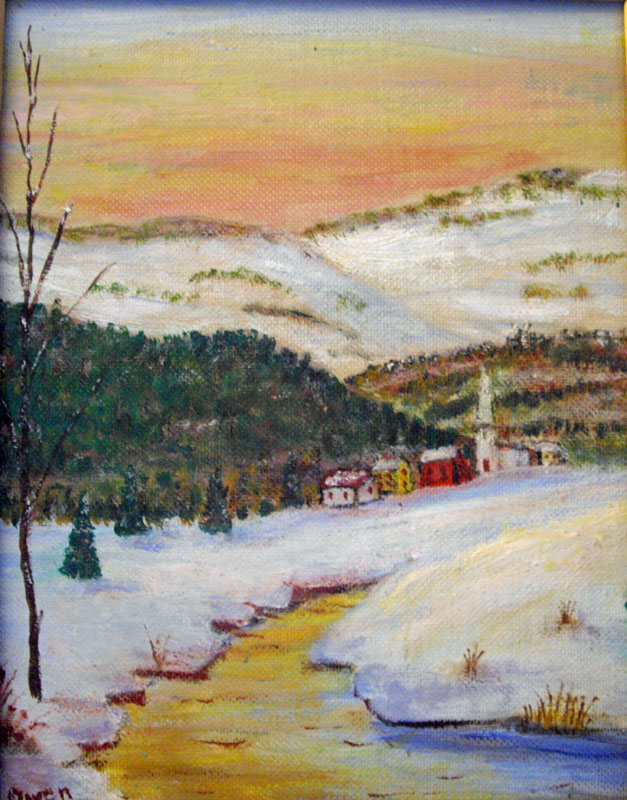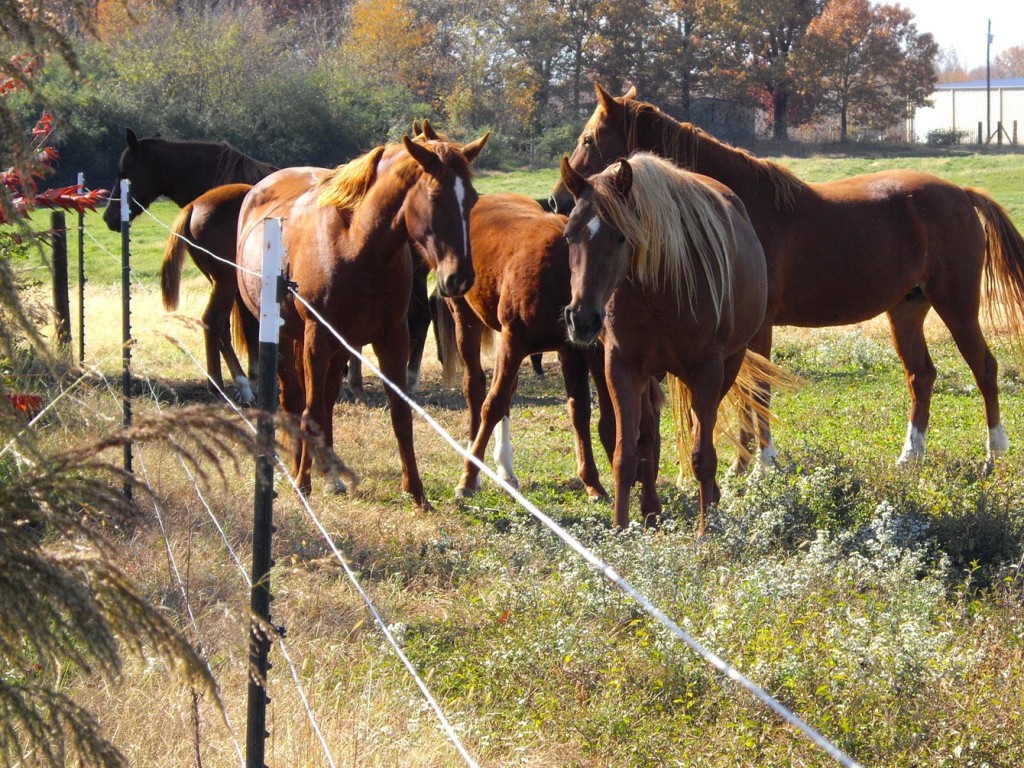|
|
 Snowy Christmas Scene – Oil painting by Margaret Morgensen Owen Each of the carols that I have chosen for 2012’s Christmas-music project have a long and rich history. The youngest of these pieces was written in 1868. As I worked on this annual labor-of-love, I have thought often of my Mother, whom we lost early in 2012 – and, who likely first taught me each of these pieces. For this reason, I decided to use one of her paintings as accompanying art. I say a prayer of thanks for her life and for her love of Christmas and its music — that I have seemingly “inherited…”
O Come, O Come, Emmanuel (Latin Hymn, 12th Century)
My arrangement of this hymn features oboe, clarinet, viola, miscellaneous strings, piano, and chimes in a multi-verse rendition of one of the oldest-known carols.
Chaconne on “While Shepherds Watched Their Flocks” (1592)
This arrangement for pipe-organ is by Betty Sue Shepherd, who was a professor of music at Samford University during my student-time there. My sister studied piano from her for four years.
Angels From The Realms of Glory (1867)
My arrangement of this old-but-not-as-old-as-the-others hymn features a baroque-like brass ensemble that alternates phrases and verses with hand-bells, pipe-organ, strings: violins 1, violins 2, viola, cello, and string bass.
O, Little Town of Bethlehem (1868)
My arrangement of this hymn is more sparse than the others. It features piano with synthesizer-padded-background a little more prominently than the other arrangements. The first verse uses solo violin. Flute and clarinet play the second verse with piano taking the third verse. The fourth verse features my near-favorite – a solo alto-ranged, stringed-instrument.
Prelude, Fugue, and Toccata on “Adeste Fidelis” (1751)
This pipe-organ arrangement is by David Lowe, who was the organist at First Baptist Church (Huntsville, AL, USA) in the mid-1970’s and played organ for my sister’s wedding. Over the years, while serving as organist here-and-there, I have performed this arrangement (in public) six (6) times from 1989 to 2001.
I hope that you enjoy this selected collection of arrangements. Merry Christmas, 2012.
 Based on the nearly-everywhere availability of high-speed Internet with its ability to deliver high-quality MP3 recordings and because of the ability of almost everyone’s computer to easily playback those recordings, I have decided to no longer provide links to MIDI files previously hosted on Creative Minds Music. I have now completed audio recordings of all of the music on the Creative Minds’ Music site and no longer link to any MIDI files there. Based on the nearly-everywhere availability of high-speed Internet with its ability to deliver high-quality MP3 recordings and because of the ability of almost everyone’s computer to easily playback those recordings, I have decided to no longer provide links to MIDI files previously hosted on Creative Minds Music. I have now completed audio recordings of all of the music on the Creative Minds’ Music site and no longer link to any MIDI files there.
In the early days of the Internet (1986, onward) I conceived of Creative Minds’ Music and began to host the music that I created, online. At that time, Internet bandwidth and a host of no-longer-relevant factors made it virtually necessary for me to only host online MIDI files and not audio recordings as representation of my work. Unfortunately, most then-available browser-based MIDI-players sounded awful — and, many still do. Better MIDI players, QuickTime and Yamaha’s MIDPlug (no longer available for Mac?) became available. Overall, the audio quality of browser-based MIDI players still pales in comparison to recordings of sounds built into hardware-based musical instruments.
The three (3) recordings (below) intend to demonstrate the relatively-poor sound of an Internet-browser playing a MIDI file, compared to modern hardware and software instruments. All three (3) recordings (below) use the same MIDI file/sequence (musical notes, timing, and expression) – but, employ different “instruments” to play back the sounds. The song is one that I composed in March, 1998. For a while, I used this song as the theme-music for Creative Minds’ Music.
The composition’s MIDI file has six (6) tracks: Acoustic Piano, Strings, Celesta, Electric Piano, Nylon-String Guitar, and Electric Bass. To (hopefully) assist your listening comparison, I suggest that you alternately play/listen to a small amount of each recording, pause, and then listen to the same section of the piece played by each other instrument.
The first recording was made by recording the output of Apple QuickTime playing a MIDI file. As poor as the sound-quality is, there were (and still are) worse MIDI players than QuickTime.
The second recording was made using the General-MIDI (GM) sound-set built into my Kurzweil PC3K8.
The third recording was made using the best instrumental sounds in my current collection: Synthogy Ivory for piano, Garritan Personal Orchestra for strings, MrRay73 Electric Piano, and with Celeste, Guitar, and Bass parts provided by my Kurzweil PC3K8.
About MIDI
First published in 1983, the Musical Instrument Digital Interface Standard (MIDI, henceforth) describes a standard by which musical instruments and other machines can send messages to each other. Another standard, the General MIDI standard (GM, henceforth) codified a set of sounds and “program numbers” by which standardized sounds could be summoned from instruments that implemented the GM standard. This “standard” sound-set was an attempt to ensure that MIDI files played by different GM instruments would sound more-or-less the same (w.r.t. general timbre and balance). Early (1991) hardware-based GM instruments, like the Roland Sound Canvas set a standard for GM instruments later made by other major musical instrument manufacturers: Roland, Korg, Yamaha, and others.
About MIDI and Me
In 1983, as I was transitioning from serious-musician to serious-software-engineer, my first self-directed, computer-programming effort used my Commodore-64 and attached Passport MIDI interface to write software to implement interrupt-driven buffering of MIDI input into my Commodore-64.
MIDI and my primary MIDI/audio application (Performer, then — Digital Performer, now) have provided me with the ability to perform, record, and then sculpt/edit my musical performances and compositions. Years before the advent of MIDI — I dreamed that the day would eventually come when I could additionally refine previously rendered performances. Once, during my adolescence, when my Mother remarked that someone had played “perfectly,” I replied: “There is no such thing as a perfect performance.”
I still believe that is true…
 The evolution of electronic instruments and their quality has reached outstanding levels. This post is being written to celebrate my newest acquisition, Garritan’s “Personal Orchestra,” which I recently purchased. The evolution of electronic instruments and their quality has reached outstanding levels. This post is being written to celebrate my newest acquisition, Garritan’s “Personal Orchestra,” which I recently purchased.
This is my first recording of this new instrument; and, I am pleased with the result – based on the limited amount of effort required to setup my previously-existing MIDI sequence to use it. In 2007, I made a series of recordings of the well-known folk-tune, “Londonderry Air” (“Danny Boy”) using several different combinations of Kurzweil and Synful Orchestra programs to audition (for family and friends) while trying to decide whether to buy “Synful Orchestra,” which I enthusiastically purchased.
All four (4) recordings (below) use the same MIDI “sequence” (musical notes, timing, and expression) – but, employ different “orchestral instruments.” To (hopefully) assist your listening comparison, I suggest that you alternately play/listen to a small amount of the recording of a particular instrument, pause, and then listen to the same section of the piece played by each other instrument.
This version uses Garritan’s “Personal Orchestra” virtual instrument. I acquired this recently, and it is the newest addition to my library of orchestral sounds.
This version uses Synful Orchestra. I once feared that soon everyone might know what a wonderful tool that “Synful Orchestra” is… and, would make recordings that sound like mine. (Half-kidding).
This version uses both “SynfulStrings” (above) and the “SMOSynthStrings” Kurzweil program discussed below. This is a blend of the two instruments and gives me ideas concerning how to create unique blends using combinations of the libraries.
This version uses a elderly Kurzweil 2500 program (“SMOSynthStrings”) that I believe may have originally been a Synclavier sample. I chose the patch/program/sound only because it was one of a selected group of orchestral, string-type programs that I regularly used before obtaining “Synful Orchestra” and “Garritan Personal Orchestra.”
I hope that you enjoy the subtle differences in these recordings. I will continue to add new recordings as I acquire new instruments.
|
|


 Based on the nearly-everywhere availability of high-speed Internet with its ability to deliver high-quality MP3 recordings and because of the ability of almost everyone’s computer to easily playback those recordings, I have decided to no longer provide links to MIDI files previously hosted on
Based on the nearly-everywhere availability of high-speed Internet with its ability to deliver high-quality MP3 recordings and because of the ability of almost everyone’s computer to easily playback those recordings, I have decided to no longer provide links to MIDI files previously hosted on  The evolution of electronic instruments and their quality has reached outstanding levels. This post is being written to celebrate my newest acquisition,
The evolution of electronic instruments and their quality has reached outstanding levels. This post is being written to celebrate my newest acquisition,
Recent Comments